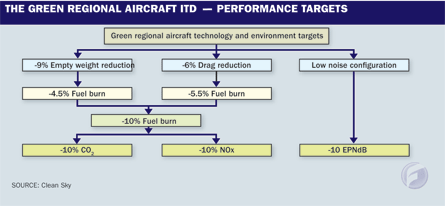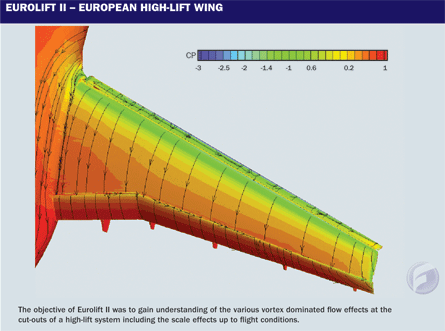It may no longer be a leader in regional aircraft manufacturing, but Europe, through the Clean Sky Joint Technology Initiative, is putting itself at the forefront of efforts to make short-haul air travel more environmentally friendly.
Clean Sky is one of Europe's largest research programmes with a budget of €1.6 billion ($2.34 billion). It is a joint bid by the European Union and its aeronautics industry to make air travel more sustainable by investigating over the next seven years the potential of vital technologies that will help manufacturers develop and bring greener products to market.
One of six technology demonstrators within Clean Sky, the Green Regional Aircraft programme, will command €174 million of the total budget and stand to benefit from the integrated research efforts of other demonstrators such as System for Green Operations and Sustainable and Green Engines.
Achille Carbone, head of special projects with Italy's Alenia Aeronautica, leader of the sub-project with EADS Casa, says its main objectives will be to achieve a reduction of 10% in fuel burn, CO2 and NOx emissions on top of advanced engines contributions, with a reduction of 10dB in effective perceived noise.
Technology demonstrator leaders, with partners ranging from Airbus, the Fraunhofer Institute, Liebherr, Rolls-Royce, Safran, Thales and various associate research institutes, will also examine what a regional aircraft boasting this level of technological innovation is likely to cost in terms of acquisition and maintenance, crucial in terms of market acceptance.
"It will be important to stay within the limits of operating costs and price of the aircraft, otherwise there will be no market. There is no point in having a beautiful proposition with no-one able to afford it," says Carbone.
Although many of Europe's regional aircraft players, including BAE Systems, Dornier, Fokker, Saab and Shorts have withdrawn from the market, leaving only ATR turboprops, the European regional fleet represents 20% of the global fleet of regional aircraft and potential demand for the next 20 years is forecast to be high, with European airlines accounting for about 26% of the orderbook.
The regional market is also in flux. Fuel economics are driving demand for more efficient aircraft, while low-cost airlines are increasingly eyeing regional services - more than 40% of new routes opened in the past five years have been operated by regional aircraft.
Carbone is clear on how the Green Regional Aircraft programme will achieve its objectives. "We will try to harness technologies at technology readiness level TRL4-5 and then mature them up to TRL6 [flight testing] to be sure that all the combined technological effects are not detrimental to one another," he says, adding that much of the effort will build on the findings of previous EU-funded research projects such as Avert and Eurolift II (see graphic below).

WEIGHT REDUCTION
Green Regional Aircraft aims to achieve an overall reduction of 9% in empty weight, centring on the use of lighter composite aerostructures and mutilayer/multifunction architectures with built-in structural health sensors achieving a potential 25% weight reduction in certain areas.
"We are going to investigate materials and configurations that have significant potential for weight reductions of the aircraft structure, employing Alenia's expertise in manufacturing and assembling composite structures for Airbus and the Boeing 787," says Carbone. "You can save a lot of weight through the use of carbonfibre on aircraft, but you have to be careful as you can add the weight back when you consider other properties you need, such as lightning strike protection, earthing, flame resistance, noise damping and impact resistance."

An enabling technology for this would adopt an innovative lightweight "sandwich" architecture to offset weight gain from these ancillary functions in a way that would make it impossible to identify separate layers.
"We can also try to achieve different properties by selecting different materials - possibly carbon nanotube-strengthened epoxy resin for increased compression and interlaminar shear strength in the fuselage and wing structures," says Carbone.
Another enabling technology would be the use of sensors so airlines could continuously control accidental damage, environmental effects and in-service structural degradation.
Researchers, focused on a new technology called fibre optic Bragg grating sensor technology, which Alenia is flight testing with a C-27J, will attempt to develop new approaches for maintenance and repair, establishing advanced methodologies to define necessary inspection intervals.
Carbone does not dismiss the contribution of metallic structures, as new alloys can in some cases equal composite performance, especially in manufacture. "We know that certain technologies we are considering can in certain areas of the primary structure achieve weight advantages of 10-15% over existing technologies, but this probably would not be possible over the entire aircraft structure, especially the less loaded parts, where going below the minimum gauge of 1mm aluminium alloy is known to have a manufacturing consideration," says Carbone.
LOW NOISE
The high frequency of regional operations at most airports means that one of the principal aims is to reduce the contribution to community noise made by regional aircraft.
The Green Regional Aircraft programme will benefit from technologies matured over past EU research programmes centred on low aerodynamic noise landing gear and high-lift devices and combine more advanced concepts that meet desired functions such as steep descent and initial climb.

Efforts will continue to focus on high-lift devices aimed at improving wing aerodynamic efficiency and load alleviation and will feature passive acoustic treatment such as brush-like devices, porous materials or serrations to reduce noise from flap side edge vortices and slat upper trailing edge vortex shedding.
Low-noise design could feature conventional three-element control surfaces and leading-edge gapless or drooped nose architectures, and kinematics to reduce noise caused by tracks and slots while maintaining high-lift performance.
Low-noise configurations of landing gear would meanwhile apply proven concepts as well as innovative solutions to gear strut and wheel pack design as well as turbulent flow control technologies such as vortex disintegrators and air curtains.

Concepts under investigation include:
All-electric aircraft. Their objective is a 3-4% cut in emissions through applying bleedless technologies capable of supplying electrical energy to on-board systems now hydraulically and pneumatically powered. "Every on-board system will be reviewed and reconsidered including electrical and electronic technologies for generation, distribution and control as well as air conditioning and pressurisation, cooling/heating and compression, ice protection and actuation," says Carbone.
Mission and trajectory management (MTM). Efforts will integrate the work of the System for Green Operations demonstrator and will focus on the definition of typical avionics architectures that integrate and validate new MTM functionalities through the use of flight simulators for new optimised missions and trajectory evaluation of typical missions that take account of new air traffic management concepts. MTM will focus on the option of jets, or more typically for regional turboprops, which allow for more agility and help increase the angle of glide path, which could be important in terms of noise.
Advanced aircraft configurations and engines. "The increasing cost of fuel and search for less-polluting aircraft and engine configurations require that novel architectures be considered," says Carbone. Open rotor and very high bypass ducted rotor engine configurations will be examined. "We want to be sure of the effects of new alternative engine technologies. For example, you can try to fit a geared turbofan on a regional aircraft and you will see landing gear weight increased, so there are some negative implications to be considered," says Carbone.
Enabling technologies will focus on powerplant integration such as innovative tail configurations, rear engine installation, shielding and vibration assessment.
TECHNOLOGY DEMONSTRATORS
A flight-test campaign using a modified ATR or a modified UAV is deemed essential to validate the regional aircraft "family" of promising technological advancements. This will be supported by windtunnel testing to determine aerodynamic efficiency and by ground testing for MTM using simulators and innovative energy management experimentation.
The next 12 months will see the technology demonstrator working firstly on the appropriate architectures before determining the reference aircraft that the technology evaluator will use. The first tender call is planned for next year and will be devoted to selecting simulation methodology and theoretical tools.
The demonstrator's final feasibility assessment and validation will, using hypothetical fleet assumptions, consider aircraft operation and regulatory and certification issues, in addition to flight safety, air traffic and regional airline requirements.
Source: Flight International























